An experience I think many have had is revisiting a game that we had memories of playing in our youth. While we all had those games that we had essentially memorized – I know stuff like Super Mario Bros. 3 and Sonic 2 so well that the ten-year-old me in my head gets actively angry when I see people not taking bonus-optimized paths through them – there are others where the memories are a little more vague. We enjoyed them at the time, but we’ve essentially forgotten the vast majority of the experience, to the point where replaying the games is like enjoying something completely new. Sometimes it’s a harsh lesson in reality, as you find out that game from your youth was utter garbage you liked because you were young, dumb and ate up anything with your favorite characters on the box. Other times, you find yourself rediscovering what you enjoyed so much, and perhaps even appreciating these titles in a brand new way through the eyes of experience.
So there’s a series of podcasts and media under the collective banner of Laser Time that I’m fond of. Most of the folks doing shows and articles there are previous or current employees of Future Publishing (whom I’ve done a fair bit of professional work for), who run the show as a way to talk about interesting pop-culture things and their own subjects of interest with friends they came to connect with through work. Laser Time manager Chris Antista recently did some stuff about Tiny Toon Adventures videogames, highlighting the many titles Konami (and others) published with the license. Among them is the Genesis/MegaDrive entry, Buster’s Hidden Treasure.
Buster’s Hidden Treasure was actually among the first games I got for the Genesis, and I remember spending way too much time defending it against my SNES-owning friends who insisted on the superiority of Buster Busts Loose as a game. It wasn’t uncommon in the 16-bit era for different platforms to get entirely different titles in a franchise or license, and Konami in particular made very, very different games for the SNES and the MegaDrive. So since you couldn’t argue over which had the better framerate or textures, you had to fight over what game was actually better, and boy did I fight tooth and nail for this one. But was I actually right, or was I just doing my duty as a pre-adolescent console warrior?
I wanted to find out. I played Buster’s Hidden Treasure again, and I’ve got a fair bit to say about it 20-some years later.
HOW I REMEMBERED IT: The game structure felt like a mix between Mario and Sonic, with a SMW-style overworld. Buster could run really fast, much like Sonic. Stages had hidden stuff and multiple exits. I couldn’t really remember individual levels or level types, save for that there were lava caves and they were REALLY hard, as was the Elmyra boss fight.
WHAT IT ACTUALLY WAS: I really had forgotten so much about this game! Vague recollections kept on materializing in my head as I played it, particularly of some of the more frustrating levels, but playing it again after so, so long felt like almost an entirely new experience.
The first thing I noticed: holy crap, Buster’s got some serious issues with gravity. Our bunny hero has an aerial falling speed more akin to an Acme brand anvil than a cute cartoon rabbit, to the point where tapping your jump button essentially does nothing – you hit the ground almost immediately. Forget bunny-hopping, you’re going to spend most of your platforming in Buster’s Hidden Treasure using full-height jumps just so you have sufficient time to adjust your landings. It’s the toughest thing in the game to get used to, and will probably cause some unintentional damage when you’re first starting out since you’ll land on foes where they can hurt you rather than the other way around.
Besides the jumping speed, however, the controls are very solid. The overall speed of Buster’s movement and the game’s running physics take a fairly obvious cue from Sonic, with Buster being able to accelerate to a good speed complete with ol’ cartoon circle-runny-legs. He can also pull off a sliding attack once he hits a certain speed, though good opportunities to utilize it are somewhat limited due to the level design.
Beyond the sliding, Buster doesn’t have much of a direct offense against foes – just the usual “jump on their heads” attack Mario made into an artform. He does, however, have a “smart bomb” option that allows him to call upon a helper character to clear the screen of enemies. You get one of these threat-eliminators by either picking up a helper item (fairly rare) or for each 100 carrots you accumulate. While the character you summon (Concord Condor, Sneezer, Little Beeper) is different depending on the stage you’re in, they all have the same screen-clearing effect. I really like that they found an effective way to work some under-loved TTA characters into the mix in this fashion.
Other ways to get around include Buster sliding down ziplines with his big, floppy ears (perhaps a precursor to some of the dangling-from-poles gameplay in Rocket Knight Adventures) and using down-diagonal inputs to crawl through small places. These particular movements stick out to me because they showcase some nice creativity with the character graphics and animation. (Heck, Buster’s spritework as a whole is outright adorable, showcasing the sort of visual craftsmanship Konami excelled at in this era.) Finally, you have a wall-jump move for Buster to get some extra height to scale walls with. Playing this again helped jog my memory: Buster’s Hidden Treasure was actually the first game I’d played to feature a wall-jump, and I remember struggling with getting caught between two walls I couldn’t jump over before I fully grasped how the mechanics worked. (It doesn’t help that wall-jumping feels particularly finicky in this game if you’re not approaching the wall at particular angles/speeds.)
But what of the stages themselves? I had a memory of them sort of being this odd mix of Sonic and Mario stage design sensibilities, and having played the game again, I can still see that – though it definitely leans more towards the Sonic school of platform level design, there’s also a noteworthy amount of more deliberately structured stages with distinct gimmicks to learn. Also like Super Mario World, several stages have multiple exits, and can be revisited more than once. If you’re a completionist, you’ll definitely want to find all of these.
Besides the alternate exits, other secrets you can find with careful exploration include extra lives (self-explanatory), additional helper summons, invincibility gems, and bells (extends your health meter by one heart and gives a full health refill). Well-hidden bonus areas, represented by the Tiny Toons rainbow logo, transport you to an item-filled zone where you try to collect stuff without prematurely touching a Gogo Dodo exit out – easier said than done, because he’s all over the place.
The bells and character summons are the things you really want, because extra lives are honestly kinda useless. Why, you ask? Besides having unlimited continues (and a password-save functionality), the stages in Buster’s Hidden Treasure do not have checkpoints. This means that no matter where you are in a level, if you’re KO’ed, it’s back to square one. Harsh! The reason why you’d want backup lives in most platformers is to resume from a checkpoint rather than having to restart a level from a Game Over/continue. Since it really makes no difference here, you’ll want more of the stuff that actively contributes to Buster’s survival instead.
The game encompasses a variety of (admittedly fairly typical) platform game terrain. The starting grassland levels up through the first two forest stages are the usual get-used-to-the-mechanics affairs, and they’re honestly pretty boring – it takes about midway through the forest levels before Konami level design cleverness starts to flow with some elaborate logging-rig levels. Not long after those, however, you’ll hit the forest maze stages, which are probably the most excruciating levels in the whole game: mess up with pathfinding and you’ll either land on some Capcom-brand Instant Kill Spikes or wind up essentially back at the beginning of the stage, needing to re-do several minutes’ worth of platforming work. Thankfully, there are only two of these ( and you only need to complete one), they aren’t multi-exit, and you will never touch them again once you’re done with them.
By the time you reach the cave levels, the game has really started to hit its stride. Tricky enemy placement (don’t just blindly run places!) and precision movement becomes more common, and the most valuable items become tougher to get. You’ll start encountering water levels, where you’ll find that Buster can sink almost as fast as he can fall, making the hazard-laden lakes even more intimidating. The fire caves are where the game starts to throw some really hard stuff at you, requiring you to figure out stage gimmicks and perform precision platforming under pressure. It’s challenging but never unfair – you’ll never have to make a completely blind jump, for example – but you’ll definitely start feeling the lack of checkpoints wearing on you.
Between the fire caves and the obligatory ice world lies a pirate ship where the titular hidden treasure is contained. It’s another maze stage, which is more tolerable here since a single mistake doesn’t always mean re-doing the whole thing (unless you hit the spikes). The ice stages that follow are more tricky jumps than slippery sliding, though your mostly-useless tiny bunny hops actually work well in getting you traction on the snow. The game’s final stretch takes you to the factories of MaxCorp, with a difficulty level worthy of being the end-stretch. It’s filled with white-knuckle, on-the-nose timing with jumps, measured movements, and enemies with nasty tricks placed in tricky, nasty places. The second-to-final level is a lengthy mishmash of the various stage design styles from before, along with some new bits like Megaman-style disappearing platform puzzles. It’s a very tough trek, but it quite mercifully breaks the mold by giving you a few scattered checkpoints (and a good helping of extra lives).
Oh, but don’t get comfy with that checkpoint generosity. See, there’s a catch to the game’s final few levels. If you lose all your lives in the factory area, including in the final stage? Back to factory stage one! (Hmm, maybe I should have registered “Megaman” along with Mario and Sonic as design inspirations for this.) Yup, all those lives that were once useless are now extremely valuable, so maybe you’ll want to go back and farm a few beforehand.
In fairly typical platformer style, every few levels you’ll encounter a boss, which consists of a normally-friendly character like Plucky or Hamton under the devious mind control of Dr. Gene Splicer. One element that makes these encounters unique is that your target is actually not the character attacking you, but the person manipulating them. If you try to go after Buster’s pals, you’ll usually wind up taking damage. The trick is finding the correct window to reach/attack the Doctor while avoiding the obstacles your buddies are being made to lob at you, which leads to some very fun (though usually not too difficult) boss fights.
You’ll also run into Montana Max twice and Elmyra once: Monty first confronts you in the hull of the pirate ship in a fight with some rather unusual stomp-timing, while the combo of Elmyra-final boss Montana makes up the final stage. I remembered Elmyra in particular being very, very difficult when I played as a youth: you have to outrun her until you reach an exit point, and she’s got instant death hugs. While I didn’t find her as frustrating this time around, she is considerably more of a threat than the weaksauce Montana Maxbot end boss. Just remember: You can jump over her to stall, and that is a huge help.
WHAT I LEARNED: So is Buster’s Hidden Treasure better than Buster Busts Loose? Well… no, it really isn’t. I mentioned already that BHT takes a bit before the stage designs really start to get challenging and interesting, but Buster Busts Loose offers a fair bit more in terms of design, setting, and gameplay variety from start to finish. BBL also allows for more in sheer gameplay mechanics, with better offensive options for Buster, more stage types, and the heavy emphasis on his multi-purpose dash move.
That certainly doesn’t mean BHT is a bad game, though. In fact, it’s a really solid 16-bit platformer with strong craftsmanship and some really fun bits. Yeah, it takes a while to get used to the jump gravity, and some of the stages can be pretty frustrating without checkpoints, but as a whole it’s definitely a cut above most of the 16-bit platformer crop. The spritework is charmingly detailed, and the colors evoke the cartoon’s vivid palette (though, again, not quite as well as in BBL). The music, too, is fantastic, making use of the distinct soundset Konami utilized across their MegaDrive games and constantly invoking the motif of the show’s theme song (much like they did with the music in their TMNT games). You can feel that distinct Konami care sprinkled throughout, and it really makes an impression.
So yes – if you dig Konami platformers – or hell, just platformers in general – and you haven’t played Buster’s Hidden Treasure before, you should definitely give it a shot! It’s easy to overlook in the shadow of BBL, but it’s a fine experience on its own. Perhaps you could say that the hidden treasure… is this game!
… yeah, I’m done now.
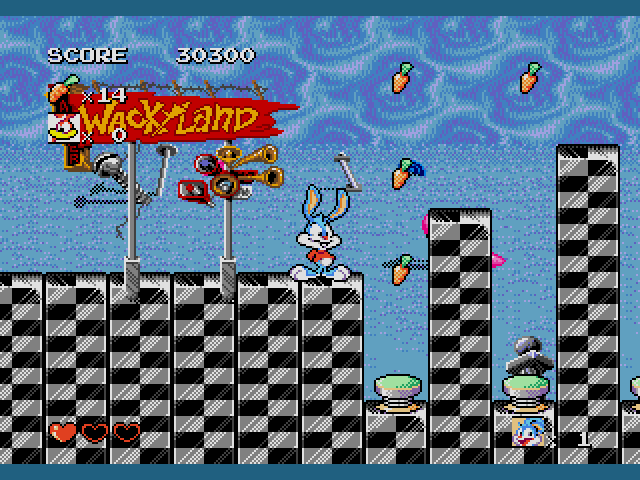
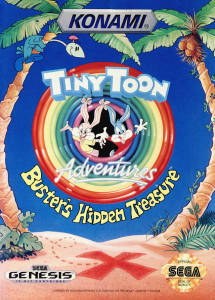
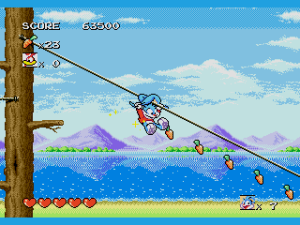
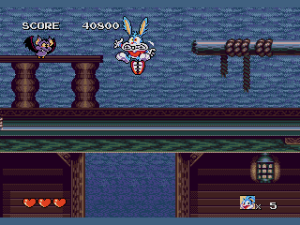
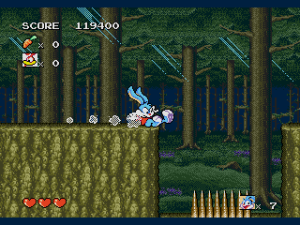

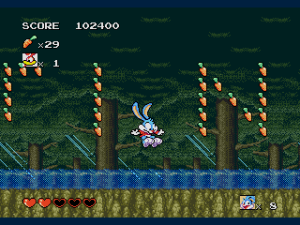
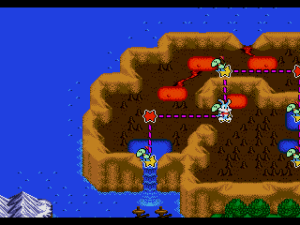
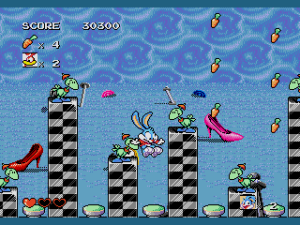
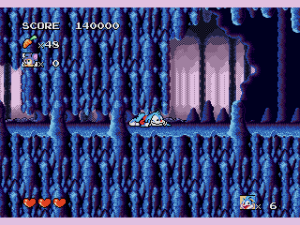
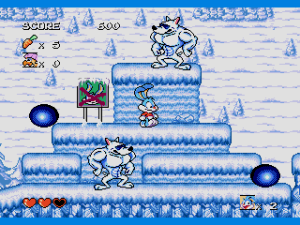
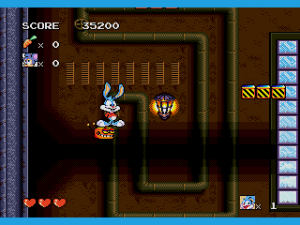

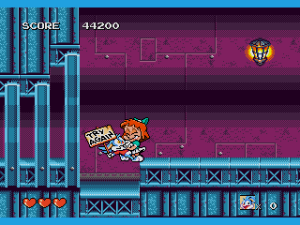
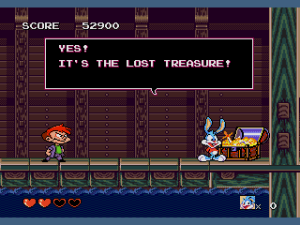
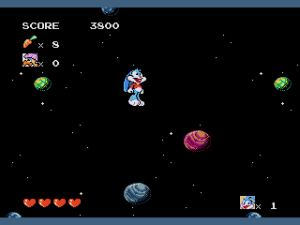
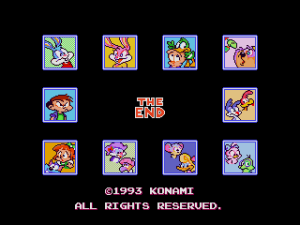
Haha! Wow, this brought me back. I would’ve fought for Buster Busts Loose as well, not because I’m a boy, but rather because I live in Panama and at the time, no one I knew had even heard of a MegaDrive and our local game rental shop/house only carried Genesis games. We probably would’ve argued just out of my own ignorance.
Thanks for the write-up, this was a pretty cool read!